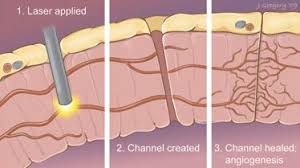 Transmyocardial revascularization (TMR) is a surgical procedure used to treat severe cases of angina caused by insufficient blood flow to the heart muscle.
Transmyocardial revascularization (TMR) is a surgical procedure used to treat severe cases of angina caused by insufficient blood flow to the heart muscle.
TMR, a surgeon creates small channels directly in the heart muscle to allow blood to flow from the inside of the heart into the surrounding muscle tissue.
TMR helps improve blood flow to areas of the heart that are not receiving enough oxygen, relieving chest pain and improving overall heart function.
TMR techniques:laser-assisted transmyocardial revascularization (L-ATMR), where a laser is used to create the channels in the heart muscle; non-laser transmyocardial revascularization (NL-TMR), which uses alternative energy sources like radiofrequency or cryoablation to create the channels.
It is believed that the channels created during TMR stimulate the growth of new blood vessels which helps to improve blood supply to the heart muscle.
TMR is typically performed on patients who have not responded well to other treatments for angina, such as medication or angioplasty.
After the TMR procedure, patients may experience some chest discomfort and are typically monitored in the hospital for a few days.
Over time, many patients report a significant reduction in angina symptoms, improved exercise tolerance, and an overall better quality of life.
Peri-operative mortality 10-20%.
In patients with severely depressed left ventricular ejection fractions mortality higher than 20%.
Perioperative morbidity 32-68%.
